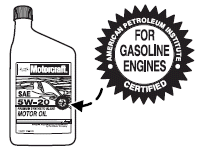Engine oil
Checking the engine oil
Refer to scheduled maintenance information for the appropriate intervals for checking the engine oil.
1. Make sure the vehicle is on level ground.
2. Turn the engine off and wait 15 minutes for the oil to drain into the oil pan.
3. Set the parking brake and ensure the gearshift is securely latched in P (Park)
(automatic transmissions) or 1 (First) (manual transmissions).
4. Open the hood. Protect yourself from engine heat.
5. Locate and carefully remove the engine oil level dipstick.
• 2.5L I4 engine

• 3.0L V6 engine

6. Wipe the dipstick clean. Insert the dipstick fully, then remove it again.
• If the oil level is within the lower and upper holes or lower and upper lines,
the oil level is acceptable. DO NOT ADD OIL.
• If the oil level is below the lower hole or the lower line, engine oil must be
added to raise the level within the normal operating range.
• 2.5L I4 engine

• 3.0L V6 engine

• If required, add engine oil to the engine. Refer to Adding engine oil in this
chapter.
• Do not overfill the engine with oil. Oil levels above the upper hole or upper
line may cause engine damage. If the engine is overfilled, some oil must be removed
from the engine by an authorized dealer.
7. Put the dipstick back in and ensure it is fully seated.
Adding engine oil
1. Check the engine oil. For instructions, refer to Checking the engine oil in
this chapter.
2. If the engine oil level is not within the normal range, add only certified engine
oil of the recommended viscosity. Remove the engine oil filler cap and use a funnel
to pour the engine oil into the opening.
3. Recheck the engine oil level. Make sure the oil level is not above the MAX, FULL
or upper hole/mark (depending on application) on the engine oil level dipstick.
4. Install the dipstick and ensure it is fully seated.
5. Fully install the engine oil filler cap by turning the filler cap clockwise 1/4
of a turn until it is seated.
To avoid possible oil loss, DO NOT operate the vehicle with the engine oil level dipstick and/or the engine oil filler cap removed.
Engine oil and filter recommendations
Look for this certification trademark.

Use SAE 5W-20 engine oil
Only use oils certified for gasoline engines by the American Petroleum Institute (API). An oil with this trademark symbol conforms to the current engine and emission system protection standards and fuel economy requirements of the International Lubricant Standardization and Approval Committee (ILSAC), comprised of U.S. and Japanese automobile manufacturers.
To protect your engine and engine’s warranty, use Motorcraft SAE 5W-20 or an equivalent SAE 5W-20 oil meeting Ford specification WSS-M2C945-A. SAE 5W-20 oil provides optimum fuel economy and durability performance meeting all requirements for your vehicle’s engine. Refer to Maintenance product specifications and capacities later in this chapter for more information.
Do not use supplemental engine oil additives, cleaners or other engine treatments. They are unnecessary and could lead to engine damage that is not covered by Ford warranty.
Change your engine oil and filter according to the appropriate schedule listed in the scheduled maintenance information.
Ford production and Motorcraft replacement oil filters are designed for added engine protection and long life. If a replacement oil filter is used that does not meet Ford material and design specifications, start-up engine noises or knock may be experienced.
It is recommended you use the appropriate Motorcraft oil filter or another with equivalent performance for your engine application.
See also:
Dual automatic temperature control
Note: You can switch temperature units between Fahrenheit and Celsius.
See Menu features in the MyFord Touch or MyLincoln Touch chapter.
A. Power/Driver temperature control: Press to turn the clim ...
Remote control
Integrated Keyhead Transmitters (IKTs) (If Equipped)
Your vehicle may be equipped with two integrated keyhead transmitters.
Use the key blade to start your vehicle and unlock or lock the driver do ...
Starting and Stopping the Engine
GENERAL INFORMATION
WARNING: Extended idling at high engine speeds can produce very high temperatures
in the engine and exhaust system, creating the risk of fire or other damage.
WARNING: Do not p ...
